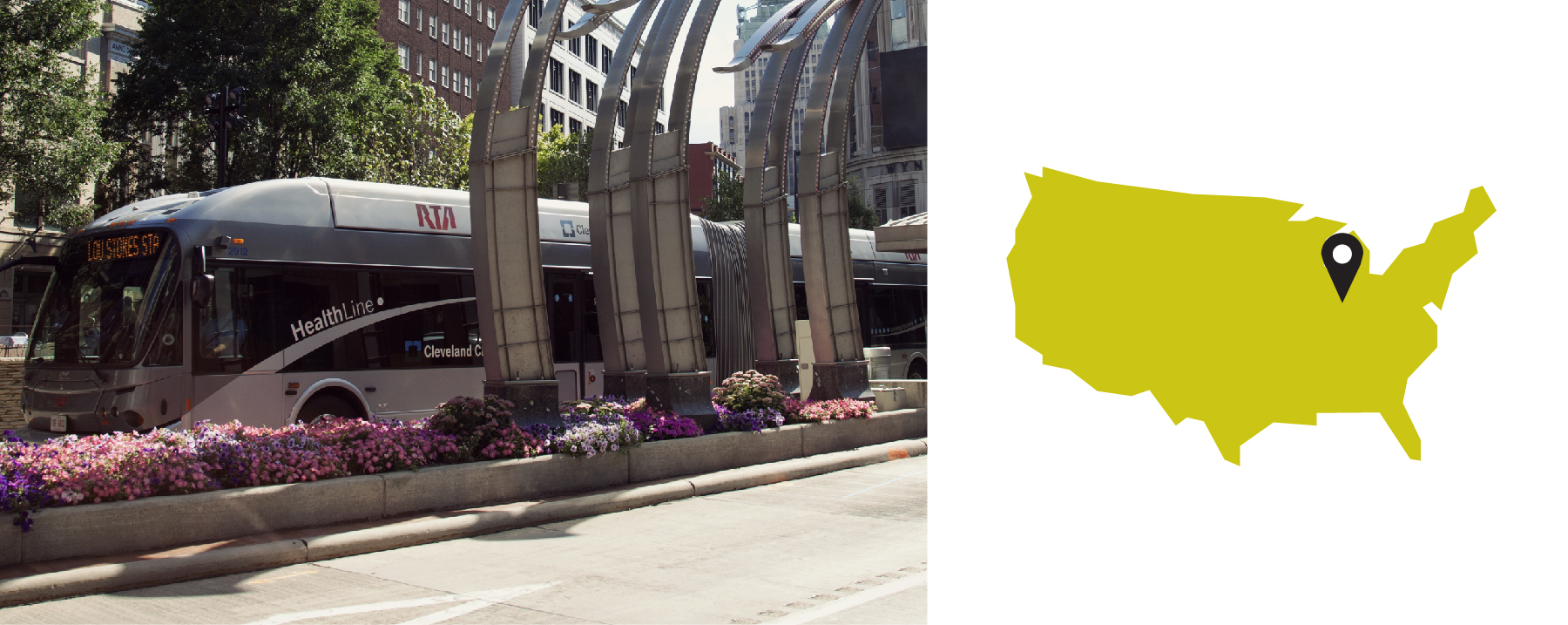BRT IN ACTION
BRT projects around the world have been improving transit options and revitalizing cities for years, and more U.S. cities are implementing or seriously considering BRT.
Global Bus Rapid Transit By The Numbers:
98 Bus Rapid Transit corridors worldwide
62 cities have implemented BRT
383% growth of BRT in the past 10 years
Sources: BRT Standard 2014 Scorecard; ITDP
BRT projects worldwide have nearly quadrupled in the past 10 years, with corridors opening up across Latin America, Europe, and Asia, while North America has lagged behind. But that’s changing, as a few U.S. cities have now experienced the benefits of high-standard corridors, and a significant number are developing plans. The following is a tour of three case studies of successful BRT.
Mexico City, Mexico
Population: 9 million (metro 21M)
BRT Ridership: 850,000 per day
Distance: 65 miles, five corridors
In the early 2000s, Mexico City had some of the worst smog and congestion problems in the world. Born out of a 2002 initiative to combat air pollution, Mexico City’s first BRT line opened in 2005, and in just its first year, replaced 350 microbuses with 97 new articulated buses, carrying 250,000 passengers per day. The system has rapidly expanded to carry close to a million riders per day.
The investment has paid off, cutting travel times in half, and reducing pollution by 35% and traffic accidents by 54%, according to one recent estimate by Metrobús. The system is used by people across demographics, and one nonprofit’s survey found that 15% of passengers were car owners. According to Metrobús, the system has been responsible for 122,000 fewer tons of CO2 per year released into the atmosphere.
The Metrobús is part of an aggressive livable streets initiative in Mexico City, which includes landscaped corridors, an integrated bike-share program, safe bike and pedestrian paths, and bike parking in state-of-the-art, well-designed stations.
Belo Horizonte, Brazil
Population: 2.5 million (metro 5M)
Ridership: 682,000 per day
Distance: 14 miles, 2 corridors
Belo Horizonte’s new MOVE transit system is a Gold Standard BRT system that opened two corridors in 2014, on a short timeline. MOVE boasts some of the highest quality execution that was highlighted during the city’s moment in the spotlight as a host city for the World Cup.
MOVE combines center-aligned stations, off-vehicle fare collection, and separated lanes that allow it to travel five times the speed of a car during peak hours. The corridor’s integration is also impressive, connecting up with the infrastructure of a crowded city (Belo Horizonte was designed in 1897 to accommodate only 100,000 people) to allow easy transfer from one mode to another, connected bike lanes, and even reserved seating for cyclists.
But design is perhaps one of MOVE’s strongest features, with modern, eye-catching stations and seating areas, and well-branded, unmistakable vehicles.
Cleveland, Ohio, USA
Population: 400,000 (metro 2M)
BRT Ridership: 15,800 per day
Distance: 7 miles, 1 corridor
Cleveland’s HealthLine is the best BRT corridor in the United States, and it’s serving as a model for North American cities looking to leverage economic development and improve connectivity. The HealthLine improved transit between two economic hubs, and drew substantial private investment to the area.
As part of a city revitalization plan, a seven-mile BRT corridor was established with just $50 million for stations, vehicles, and platforms, and another $150 million for road improvements and street enhancements.
The result is the only Silver-rated BRT line in the United States, with platform-level boarding, central median alignment, off-board fare collection, and modern, sleek stations that serve as landmarks. Articulated, silver vehicles could be mistaken for streetcars at a glance. From its launch in 2008 to 2013, ridership increased by 67%, and particulate emissions in the corridor were reduced by 95% thanks to low emission, hybrid vehicles.
The area saw $5.8 billion in private real estate investments following the opening of its HealthLine BRT corridor. When compared to rapid transit corridors elsewhere in the United States, that’s more real estate development than what has occurred, per dollar invested, than in light rail projects over similar time periods. Specifically, Cleveland experienced $114 worth of private real estate investment per dollar the city spent on BRT.
“The HealthLine has not only dramatically improved transportation options from downtown to University Circle, it’s also been a catalyst for nearly six billion dollars of real estate investment along Euclid Avenue and is contributing a great deal toward revitalizing the city.”
CO2 EMISSIONS & AIR QUALITY
When transit serves larger numbers of passengers, there are fewer cars on the road and less pollution. As Boston experiences the level of growth antic- ipated in the next 10–20 years, the city’s environmental impact through air pollution will be heavily dependent on its public transit system. BRT can move large numbers of people more efficiently, which would mean lower greenhouse gas emissions.
Relative to rail, however, the biggest environmental concern about BRT is that most diesel buses are major producers of particulate emissions, which contribute to poor air quality. There are alternative fuel options for BRT vehicles that include compressed natural gas, low-emission liquefied petroleum gas, and hybrid vehicles, all of which can reduce emissions.






